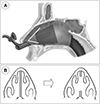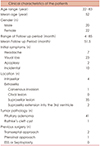Abstract
Background and Objectives
The conventional transseptal transsphenoidal approach can inhibit visualization of the surgical field and may change the shape of external nose. We used the transseptal transsphenoidal technique to remove septal cartilage except the L strut via a modified Killian's incision and preserved the ‘key-stone area.’ The aim of this study was to verify the usefulness of this technique.
Subjects and Method
Retrospective analysis was carried out on 42 pituitary tumor patients who received this technique by a single otolaryngologist from March 2005 to March 2012 at Kangbuk Samsung Hospital.
Results
The mean patient age at time of surgery was 52 years, and 41 cases were pituitary adenoma and 1 was Rathke's cleft cyst. Three patients had undergone prior surgery; of which 2 used a pterional approach and 1 a transsphenoidal approach. With regard to complication, there were 2 cases of CSF leakage and 5 cases of septal laceration. There were no cases of meningitis, deformity of external nose, septal perforation, anosmia, or sinusitis. In post operation follow up, 25 cases (59.5%) had no residual tumor, while 17 cases (40.5%) had residual tumor.
Figures and Tables
 | Fig. 1Diagrammatic representation of trasseptal transsphenoidal approach with septal cartilage removal and replacement via modified Killian incision. White line: L -strut, Grey zone: area of cartilage harvest and reposition (A). Removal of septal cartilage conserving L-strut (B). |
 | Fig. 2Diagrammatic representation of endoscopic transnasal approach. Nasal speculum used to fracture the posterior bone of nasal septum to reach anterior wall of sphenoid sinus (A). Opening speculum fully makes the nasal septum be dislocated unilaterally. it usually results in an associated tear in the septal nasal mucosa close to the ethmoidal crest on the anterior surface of the sphenoid bone (B). |
References
1. Black PM, Zervas NT, Candia GL. Incidence and management of complications of transsphenoidal operation for pituitary adenomas. Neurosurgery. 1987; 20:920–924.

2. Armengot M, Gallego JM, Gomez MJ, Barcia JA, Basterra J, Barcia C. [Transphenoidal endoscopic approaches for pituitary adenomas: a critical review of our experience]. Acta Otorrinolaringol Esp. 2011; 62:25–30.

3. Wilson CB. Endocrine-inactive pituitary adenomas. Clin Neurosurg. 1992; 38:10–31.
5. Youssef AS, Agazzi S, van Loveren HR. Transcranial surgery for pituitary adenomas. Neurosurgery. 2005; 57:168–175. discussion 168-75.

6. Cho JH. Endoscopic endonasal transsphenoidal skull base surgery. Korean J Otorhinolaryngol-Head Neck Surg. 2010; 53:135–142.

7. Jho HD, Carrau RL, Ko Y, Daly MA. Endoscopic pituitary surgery: an early experience. Surg Neurol. 1997; 47:213–222. discussion 222-213.

8. Nasseri SS, Kasperbauer JL, Strome SE, McCaffrey TV, Atkinson JL, Meyer FB. Endoscopic transnasal pituitary surgery: report on 180 cases. Am J Rhinol. 2001; 15:281–287.

9. Kabil M, Eby J, Shahinian H. Fully endoscopic endonasal vs transseptal transsphenoidal pituitary surgery. Minim Invasive Neurosurg. 2005; 48:348–354.

10. Goudakos JK, Markou KD, Georgalas C. Endoscopic versus microscopic trans-sphenoidal pituitary surgery: a systematic review and meta-analysis. Clin Otolaryngol. 2011; 36:212–220.

11. Rotenberg B, Tam S, Ryu WHA, Duggal N. Microscopic versus endoscopic pituitary surgery: a systematic review. Laryngoscope. 2010; 120:1292–1297.

12. Ammirati M, Wei L, Ciric I. Short-term outcome of endoscopic versus microscopic pituitary adenoma surgery: a systematic review and meta-analysis. J Neurol Neurosurg Psychiatry. 2013; 84:843–849.

13. Dhong HJ, Park JH, Kim JH. Endoscopic transnasal transsphenoidal pituitary surgery. Korean J Otolaryngol-Head Neck Surg. 1999; 42:734–737.
14. Pereira EA, Plaha P, Chari A, Paranathala M, Haslam N, Rogers A, et al. Transsphenoidal pituitary surgery in the elderly is safe and effective. Br J Neurosurg. 2013.

15. Tao YX, Qu QY, Wang ZL, Zhang QH. Endoscopic transsphenoidal approach to pituitary adenomas invading the cavernous sinus. Chin Med J (Engl). 2010; 123:3519–3523.
16. Rotenberg B, Tam S, Ryu WH, Duggal N. Microscopic versus endoscopic pituitary surgery: a systematic review. Laryngoscope. 2010; 120:1292–1297.

17. Kahilogullari G, Beton S, Al-Beyati ES, Kantarcioglu O, Bozkurt M, Kantarcioglu E, et al. Olfactory functions after transsphenoidal pituitary surgery: endoscopic versus microscopic approach. Laryngoscope. 2013; 123:2112–2119.

18. Griffith HB, Veerapen R. A direct transnasal approach to the sphenoid sinus. J Neurosurg. 1987; 66:140–142.

19. Ciric I, Ragin A, Baumgartner C, Pierce D. Complications of transsphenoidal surgery: results of a national survey, review of the literature, and personal experience. Neurosurgery. 1997; 40:225–236. discussion 236-227.

20. Kahilogullari G, Beton S, Al-Beyati ES, Kantarcioglu O, Bozkurt M, Kantarcioglu E, et al. Olfactory functions after transsphenoidal pituitary surgery: endoscopic versus microscopic approach. Laryngoscope. 2013; 123:2112–2119.

21. Koutourousiou M, Gardner PA, Tormenti MJ, Henry SL, Stefko ST, Kassam AB, et al. Endoscopic endonasal approach for resection of cranial base chordomas: outcomes and learning curve. Neurosurgery. 2012; 71:614–624. discussion 624-615.




 PDF
PDF ePub
ePub Citation
Citation Print
Print





 XML Download
XML Download